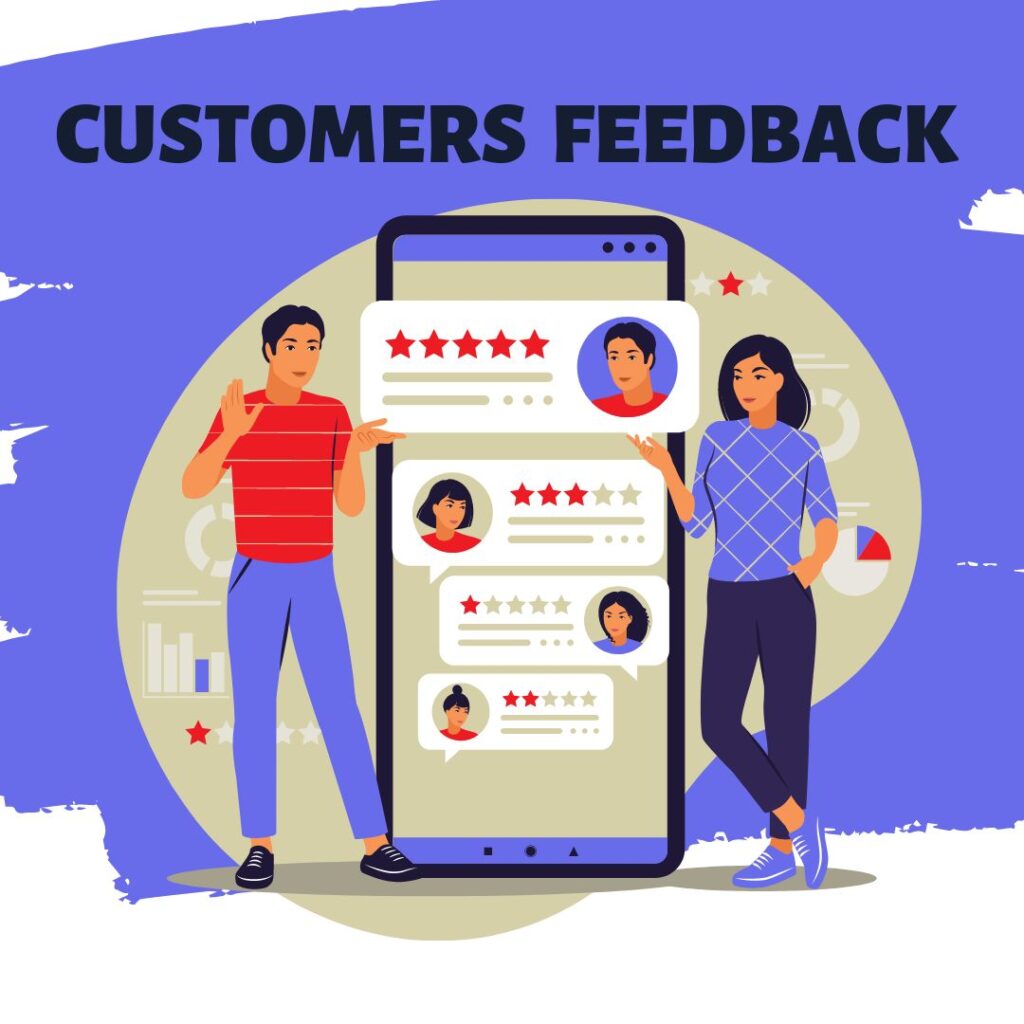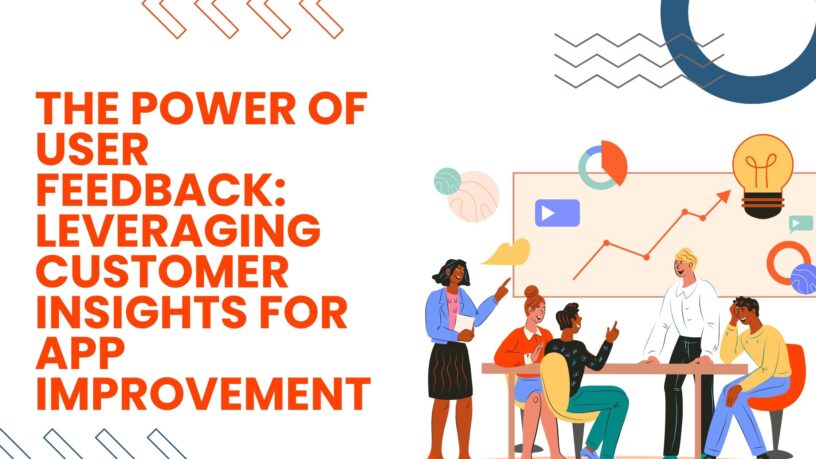You’ve put your vision into pixels and code, and your digital dream, your app, is now out there. Yet, despite the sweat, sleepless nights, and strategic planning, the numbers aren’t adding up. Engagement is lagging, retention is a challenge, and growth seems elusive.
Every startup faces initial hurdles, but the continuing disconnect between your app and its users might signal deeper issues. In the race of technology, not listening to your users could set you miles behind your competition, turning your digital dream into a sinking ship.
The antidote to this ailment?
User Feedback. A potent tool that, when wielded right, can be the cornerstone of app development and improvement.
The ‘Why’ Behind the Metrics
In the digital world, where data is abundant, metrics provide a clear picture of user interactions. These quantifiable measures—like user retention, session duration, and click-through rates—offer essential insights into how users engage with an app. But while metrics can tell us the ‘what’ and ‘how’, they often don’t reveal the ‘why’. Understanding the motivation and reasons behind these numbers is crucial for any tech startup founder or entrepreneur aiming for genuine improvement and connection with their users.
Take the case of Instagram. In its early days, Instagram was primarily a photo-sharing app, with its filters and straightforward UI being its standout features. As more and more users started engaging, the platform, like any other tech enterprise, began relying on metrics to track its performance. But the real magic began when they decided not just to observe these metrics but to actively seek out the reasons behind them.
When Instagram introduced the Stories feature, they observed an uptick in user engagement. The metrics clearly showed that users were frequently using Stories, sometimes even more than the regular post feature. But why were users gravitating towards this feature? What made Stories so compelling?
The Instagram team delved deeper, not just relying on the quantitative data but actively seeking qualitative feedback. Through surveys, user feedback, and possibly analyzing the content type users were sharing, they understood that the ephemeral nature of Stories (where content disappears after 24 hours) gave users a sense of freedom. It allowed users to share more candid moments without the pressure of the ‘perfect post’. This fleetingness, combined with the real-time sharing capability, gave users a more authentic way to connect with their followers.
Armed with this insight, Instagram did not rest on its laurels. They started to expand and refine the Stories feature. New capabilities, such as stickers, polls, music overlays, and more, were introduced, making the Stories experience richer and more interactive. The metrics provided the initial hint, but understanding the ‘why’ behind them enabled Instagram to make the feature integral to its platform.
This journey of Instagram underlines a vital lesson. While metrics give a snapshot, the real understanding—the ‘why’—comes from deep engagement, listening, and analysis. It’s about bridging the gap between numbers and human behavior, something every tech startup founder should strive for to create products that resonate deeply with users.
Understanding Feedback’s True Potential
Every successful digital platform lies a secret weapon: an intimate understanding of its users. While metrics and analytics can provide an overview, it’s the nuances of user feedback that reveal the finer details. Tapping into this resource is akin to unlocking a goldmine of insights, showcasing not just what users think of the product, but more importantly, what they yearn for.
Feedback isn’t merely about addressing shortcomings; it’s about discovering opportunities. Every piece of input, be it praise, criticism, or a simple suggestion, holds a clue to the evolving desires and expectations of the user base. By keenly analysing these clues, founders can anticipate needs, refine offerings, and even identify potential innovations that could redefine their market space.
The beauty of feedback lies in its organic nature. Users, in expressing their thoughts, don’t just highlight issues—they often provide solutions, offer ideas, and envision enhancements. For startups, this is invaluable. It’s direct access to user-driven innovation.
Spotify’s success story is a testament to the transformative power of user feedback. At its core, Spotify is more than just a music streaming service—it’s a platform that understands and evolves with its users’ musical journeys. The recommendation engine, pivotal to Spotify’s allure, has been perpetually honed through user feedback. Features like “Discover Weekly” and “Release Radar” are not just algorithm-driven but are fine-tuned every time a user likes or skips a track. It’s a symphony of tech and feedback, culminating in a personalized musical experience for each user.
By embracing feedback’s potential, Spotify didn’t just improve—they revolutionized the way we discover and enjoy music.
The Power of Negative Feedback
Receiving feedback is inevitable in the ever-evolving realm of technology.. However, negative feedback often elicits an immediate, defensive reaction. It’s seen as a setback, an indication of failure. In reality, it’s anything but that. Negative feedback is a gold mine, a rare opportunity to glimpse the genuine sentiments of your user base. And this raw, unfiltered honesty, when channeled constructively, can lead to game-changing improvements.
Firstly, negative feedback provides clarity on user pain points. These are direct indicators of areas requiring improvement. Rather than wading through ambiguous data, negative feedback often offers a clear roadmap to the necessary changes.
Secondly, by addressing the issues highlighted by negative user feedback, companies demonstrate that they genuinely listen to and value their customers. This not only resolves current pain points but also builds trust and loyalty, ensuring longer user retention.
Thirdly, in a saturated market, every app or software has competitors. Negative feedback can serve as a competitive edge. By swiftly and effectively responding to such feedback, a company can distinguish itself from its competitors who might be slow or resistant to change.
A poignant illustration of this principle is Microsoft’s journey with its Windows operating system. The launch of Windows 8 was met with significant criticism, especially regarding its user interface. The removal of the familiar Start button and the imposition of the tile-based Metro UI left many users frustrated and disgruntled. Rather than dismissing these complaints or doubling down on their design decisions, Microsoft chose to listen. They acknowledged the feedback and acted upon it.
When Windows 10 was unveiled, it brought back the beloved Start button and offered a more flexible UI, bridging the best of both worlds. The result? A surge in positive reception and user adoption. This turnaround was not merely because of design improvements but was primarily driven by Microsoft’s willingness to listen, learn, and iterate based on user feedback.

Feedback as a Community-Building Tool
The relationship between a brand and its users goes beyond mere transactions in the hyper-connected world of today.The modern consumer seeks not only a product or service but a sense of belonging and connection. This is where feedback plays a monumental role in community-building.
The Foundation of Community
Feedback forms the cornerstone of any thriving community. It’s a two-way dialogue, a continuous exchange of ideas, and a testament to the fact that a brand values its users’ voices. When users feel their feedback is genuinely acknowledged and acted upon, they sense ownership over the product, an essential ingredient in building a loyal community.
The Psychological Impact
Humans have an innate desire to belong, to be a part of something larger than themselves. When a brand involves its users in the development process through feedback loops, it taps into this fundamental human need. This inclusivity fosters a sense of pride among users. They are not just consumers but contributors, helping shape the direction of the product.
Tesla and the Power of Direct Engagement
Tesla stands as a shining example of harnessing feedback for community-building. Their strategy revolves around direct engagement, primarily on platforms like Twitter.
Elon Musk, the CEO of Tesla, is known for his active presence on the platform. It’s not uncommon for users to tweet feedback or suggestions about Tesla products directly to Musk. What’s exceptional, however, is his propensity to acknowledge and sometimes even implement these suggestions.
Take the case of a Tesla owner who pointed out the need for a feature that displays the car’s available range in the main window of the Tesla app. Musk responded directly to the tweet, acknowledging its utility, and within days, the feature was rolled out in an update. This rapid turnaround not only addressed a user need but showcased Tesla’s dedication to its community.
Such interactions, amplified by the reach of social media, generate waves of positive sentiment. Tesla owners and enthusiasts feel a deep connection with the brand, believing that their voices matter. This has fostered a profound sense of community among Tesla users, where they see themselves as co-pilots, helping steer the brand’s direction.
Feedback-driven Marketing Strategies
Consumers are inundated with advertisements, making it challenging for brands to stand out. Traditional advertising tactics often fall flat because they lack a personal touch or authenticity, which today’s discerning consumers crave. Enter feedback-driven marketing strategies.
Understanding Authenticity in Marketing
Authenticity in marketing is about maintaining a genuine connection with your audience. When consumers believe they’re not just being sold to, but are being listened to, they’re more likely to engage with a brand. Leveraging user feedback in marketing strategies ensures that promotional content resonates with the audience’s actual experiences and desires, making it far more compelling.
How Feedback Shapes Marketing Campaigns
When businesses take into account user feedback, they can tailor their marketing efforts in several impactful ways:
Highlighting Desired Features: Feedback can reveal what users love most about a product. Brands can then emphasize these beloved features in marketing materials.
Addressing Concerns Proactively: If users have reservations or criticisms, addressing them head-on in marketing content can demonstrate transparency and a commitment to improvement.
User-Generated Content (UGC): Incorporating feedback into marketing often leads to UGC, which lends authenticity to campaigns as potential customers see real users enjoying or benefiting from a product.
Apple’s “Shot on iPhone” Campaign
Apple’s “Shot on iPhone” campaign is a testament to the power of feedback-driven marketing. The tech giant recognized through user feedback that people were raving about the high-quality photos they could take with their iPhones. Instead of just touting technical specifications, Apple chose to showcase actual photos taken by everyday users, turning the spotlight on the user experience.

This campaign did several things:
User Validation: By featuring real photos from iPhone users, Apple validated the feedback of its user base, demonstrating that they were listening.
Trust and Relatability: Potential buyers saw real-world results, not just staged promotional shots, fostering trust and making the camera’s capabilities more relatable.
Community Engagement: The campaign encouraged more users to share their shots, fostering a sense of community and engagement around the iPhone’s photography capabilities.
The Ripple Effect of Feedback-driven Marketing
The benefits of integrating user feedback into marketing extend beyond just the immediate campaign. When users see their feedback being acknowledged and acted upon, it fosters brand loyalty and encourages further engagement. It creates a virtuous cycle where feedback leads to better marketing, which in turn leads to more feedback, allowing brands to continually refine their messaging and stay in tune with their audience’s evolving needs.
Incorporating user feedback into marketing strategies not only enriches the content but also deepens the connection between the brand and its users. When executed well, it transforms standard promotional content into powerful narratives that resonate deeply with the target audience.
Embracing Evolution through User Dialogue
In the realm of app development, creating a static product is a misstep. To succeed, apps must be living entities, capable of evolving alongside user needs. Achieving this level of adaptability hinges on establishing an ongoing, ever-evolving dialogue with users.
Why it is crucial?
Staying Ahead of the Curve: As user behaviors shift and technology trends change, maintaining an ongoing conversation with the user base keeps apps relevant and up-to-date.
Building Trust: Users want their voices heard. Recognizing that their feedback directly impacts app improvements builds trust, fosters loyalty, and deepens the brand-user relationship.
Anticipating Needs: Engaging with users uncovers emerging needs before they become mainstream. This foresight provides brands with a competitive edge.
Early Issue Detection: Regular feedback mechanisms catch potential issues early, averting larger complications down the road.
Driving Growth: User insights lead to feature enhancements, usability improvements, and innovative additions that guide the app’s evolutionary journey.
Slack, a renowned corporate communication platform, is a testament to the power of active user engagement. Acknowledged for its attentiveness to user feedback, Slack has integrated numerous user-suggested features—ranging from refined search functions and streamlined notifications to expansive third-party tool integrations. This iterative refinement, rooted in user feedback, has positioned Slack as a premier choice in corporate communication tools.
Furthermore, Slack’s release notes often reflect their commitment to user-driven evolution. By fostering an unwavering dialogue with their users, brands like Slack ensure their offerings resonate deeply, adapting in tandem with evolving user landscapes.
This continuous dialogue underscores the principle that successful applications aren’t merely constructed; they grow, adapt, and evolve hand-in-hand with their user communities.
Beyond Reactive Measures
Addressing user concerns and resolving issues is essential, but true innovation necessitates a proactive approach that goes beyond mere reactivity. It involves harnessing feedback to spot emerging trends and shape the future trajectory of an application.
Why is proactive innovation important?
Building Early Adopters: Anticipating trends means catering to early adopters—the users who embrace new features or concepts ahead of the curve. These users can become valuable evangelists for the app, driving its growth and popularity.
Enhancing User Experience: Being proactive allows brands to address potential pain points before they escalate, resulting in a smoother user experience and higher satisfaction rates.
Strategic Advantage: Innovating based on user feedback can give brands a competitive edge, setting them apart from others that solely react to user complaints.
Creating Brand Ambassadors: Users who witness their suggestions taken seriously and implemented are more likely to become loyal brand advocates, actively promoting the app to others.
Netflix is a prime example of leveraging feedback for proactive innovation. Recognizing the rising trend of binge-watching, where viewers watch entire seasons in one sitting, Netflix introduced a revolutionary approach. They began releasing entire seasons of their original series all at once, allowing users to indulge in binge-watching to their heart’s content. This shift in content release strategy not only catered to the changing way people consumed content but also solidified Netflix’s reputation as a trailblazer in the streaming industry.
By identifying the emerging behavior of binge-watching through user feedback, Netflix demonstrated its commitment to anticipating trends and meeting user needs even before they became mainstream. This proactive approach not only pleased existing users but also attracted new subscribers who valued this novel viewing experience.
In essence, Netflix didn’t just rely on reactive user feedback; they used it as a crystal ball to anticipate and capitalize on a burgeoning trend, proving that innovation driven by user feedback can be a game-changer in the competitive landscape.
In the world of app entrepreneurship, understanding and acting on user feedback isn’t just beneficial—it’s essential. As a founder, embrace this quote.
“Your users are your compass, guiding your app towards success”.
Remember, at Appomate, we’re here to support every step of your journey, ensuring that app entrepreneurship becomes faster, safer, and more successful for you.
Contact us today to start your mobile app development journey!
